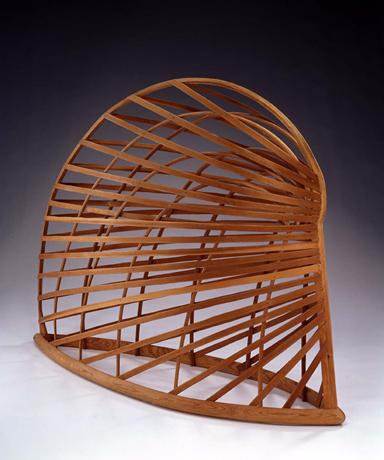Martin Puryear’s ‘Multiple Dimensions’
By • June 29, 2016 0 1017

There is a frequent dilemma in the perception of art that dates back at least to the 19th century. It is the notion that if a piece of art appears “effortless,” the obvious conclusion is that little effort went into its creation. Critics slammed Matisse for the simplicity of his work, comparing him to a monkey with a paintbrush. Whistler even had to defend the price of his work in court, famously stating that he asks it not for a few days’ labor but “for the knowledge I have gained in the work of a lifetime.”
The wall text of “Multiple Dimensions,” the Smithsonian American Art Museum’s graceful exhibition of work by Martin Puryear, on view through Sept. 5, more or less states that the effortless impression of Puryear’s sculptural forms belie the effort he put into them. But I disagree.
To me, Puryear’s sculptures do not appear “effortless” so much as worn down to their most basic and essential structures. You can see a mind continually at work, unraveling ideas both formal and structural. You can see the compression of forms, symbols, time, space and emotion into a singular material presence. You see the raw force of earth and the industrial grandeur of construction.
His final forms are pared away, like the mushroom rocks of the Negev desert, worn by the erosion of sandstorms to a unique, peculiar but fundamental essence. Effortless? It would be more appropriate to say that they appear to be “inevitable.”
The work is abstract, to be sure, but it is wed with such devotion to materiality and structure that it defies such tidy definition. We are treated to something more like a presentation of cultural artifacts: the skeleton of an ancient barge immaculately restored and pieced crookedly together; a thin maple sapling bent and coerced into an imperfect circle that hints at infinity; an oblong earthen mound that loosely takes the form of a head, as if it were amidst delicate excavation from the clay.
This is all in discussion of Puryear’s sculptures. His drawings, on the other hand, which are exhibited far less regularly, offer beautiful insight into the way the artist thinks and works.
Negative space plays an important role in Puryear’s sculptures, from the aforementioned maple sapling circle, which hangs on the wall like an empty, primitive frame, to freestanding sculptures like “Bower,” where warped wood is loosely woven to form a sort of armature, allowing viewers to see right through it.
The exhibition displays his drawings and studies around the finished sculptures, showing the diverse sources from which he generates his ideas. Puryear’s longtime interest in architecture goes back to his Peace Corps years in Sierra Leone, where he drew many of the buildings he saw (some of these drawings are on display). He pulls influence from many building traditions: Plains Indian teepees, Inuit igloos, Mongolian yurts.
As a result, his works on paper take the form of architectural drawings. Interestingly, he says that in these sculptural studies he is concerned mainly with working out the means and methods of building rather than the appearance of the object; structural issues determine the way a piece will look. In contrast, drawings by architects, who do not themselves construct the buildings they design, reveal that they are often occupied with how a structure should look before considering how it should be built. The show includes a woodcut series, illustrations for an edition of Jean Toomer’s Harlem Renaissance masterpiece “Cane,” which is in some way the clearest example of Puryear’s particular artistic gifts.
Notably in this series, but also in the large majority of his work, Puryear confronts what it means to be a black artist in America. There is a unique cultural kernel that lies at the heart of everything he does, without betraying the mercurial mystique and open-ended intellectual space of the best and most lived-in abstraction.
The gallery labels necessarily discuss the allusions of pieces like “Shackled,” a literally elephantine structure with what looks like an oppressively heavy iron bridle affixed to the area around its face. It speaks to a specific colonial history, giving it its own visual language for our modern era.
From the prototypical form of an African mask to the very materials originally used in the enslavement and transportation of Africans, from knotted hardwood saplings like warped lives cut short by the hands of others to drawings of conch-like forms inspired by the Phrygian caps of the French Revolution, Puryear’s work intertwines African and European histories in a way that elicits a universal struggle for survival and legacy.

